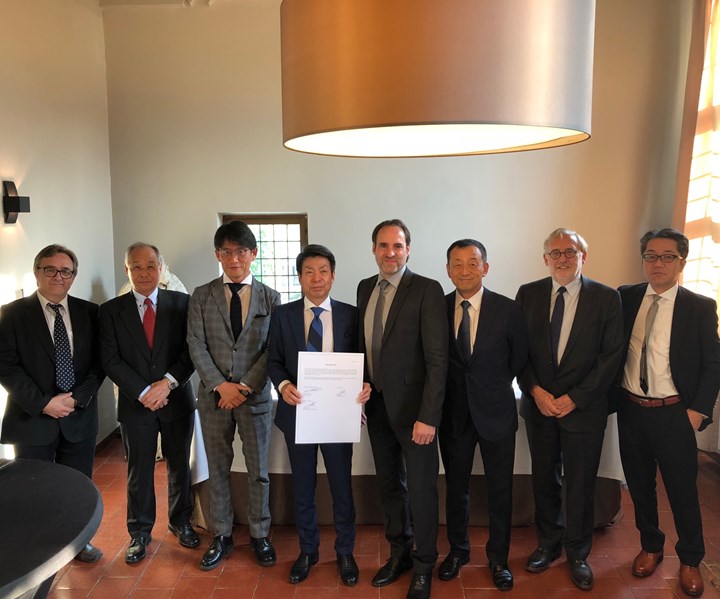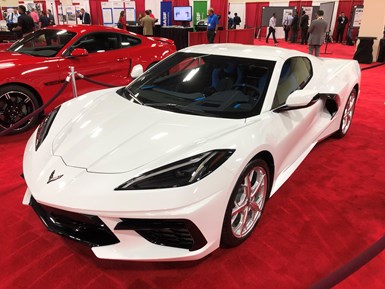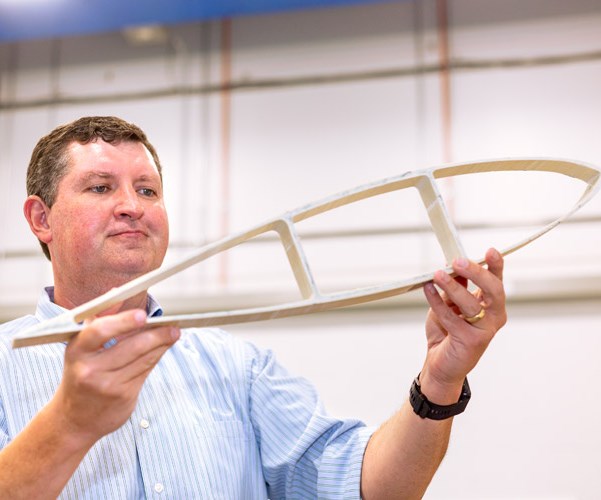CompositesWorld News for Dec. 26, 2019
Read news from Gurit UK, EconCore, Society of Plastics Engineers, and Scott Bader Company
Gurit signs long term core material supply agreement with Chinese wind turbine blade OEM
The three-year contract is a continuation of an existing business relationship for the supply of core materials.

Source | Gurit
Gurit Services AG (Zurich, Switzerland) has announced that it has secured a supply contract for core materials with a Chinese wind turbine blade producer supplying international and domestic OEMs.
The three-year contract covers the years 2020 – 2022 and is a continuation of an existing business relationship for the supply of core materials. It is expected to deliver Net Sales of CHF 25 million over the contract period, half of which will be for PET core material.
“This is another milestone of achieving a long-term supply agreement with a leading blade producer in China, the world’s largest wind energy market.” says Rudolf Hadorn, CEO of Gurit.
Gurit plans to increase its PET extrusion capacities in 2020 at the existing extrusion sites in Tianjin, China as well as in Matamoros, Mexico.
Automotive interior Tier 1 supplier signs license for EconCore technology
Japanese manufacturer Kokobukiya Fronte will use EconCore’s production technology to produce honeycomb materials under brand name M-Light.

Source | EconCore
EconCore (Leuven, Belgium), which is known for continuous production of thermoplastic honeycomb sandwich materials, has signed a license agreement with Kotobukiya Fronte, a Japanese Tier 1 supplier of car interior components, to install EconCore’s production technology at its facilities. Kotobukiya Fronte’s honeycomb material solutions are offered under the brand name M-Light.
EconCore offers a cost-effective, continuous, high-volume production process for lightweight thermoplastic honeycomb sandwich panels. The company reports that its customers and licensees in Europe, Asia and the Americas have already entered the transportation market with the honeycomb technology.
Using EconCore's technology, Kotobukiya Fronte is now integrating production of the rigid sandwich panels with in-line lamination of nonwoven and carpet surface layers, which reportedly enables a more efficient production process for the company’s finished automotive interior elements. Furthermore, the lightweight thermoplastic honeycomb panels can be converted into relatively complex shaped parts within a short compression molding process cycle.
“We’ve seen the market shift to lighter, sustainable materials and OEMs insist on keeping costs competitive at the same time. This development is helping to evolve the automotive interior market and EconCore’s technology is helping to transform the market with its superior performance and enhanced acoustic properties,” says Jochen Pflug, CEO of EconCore. “We are confident Kotobukiya Fronte is the right partner to develop new honeycomb products for automotive interiors and we are keen to support them with their innovative plans.”
“This material with our production technologies can bring a positive impact on the acoustic performance, light weight [and] rigidity of automotive parts. We believe the product with this material can satisfy automotive OEM customers globally,” says Mr. Tsuchiya, CEO of Kotobukiya Fronte.
SPE ACCE issues call for papers for 2020 conference
Paper abstracts are due April 17, 2020, and final papers or non-commercial presentations are due June 19, 2020.

A presentation from SPE ACCE 2019. CW photo | Scott Francis
The Society of Plastics Engineers’ (SPE) Automotive Composites Conference & Expo (ACCE) team has issued a call for papers, exhibitors and sponsors for its 20th annual event to take place Sept. 9-11, 2020 in Novi, Mich., U.S. The theme for the 20th anniversary event is “Driving Innovation Transportation,” with a focus on polymer composites as the leading technology driving innovation in automotive electrification, mobility and autonomy.
The 2020 ACCE technical program will include 80-100 papers and presentations on industry advances, organized into the following categories:
- thermoplastic composites,
- thermoset composites,
- modelling,
- additive manufacturing and 3D printing,
- enabling technologies,
- sustainable composites,
- bonding, joining and finishing,
- carbon fiber composites and
- business trends and technology solutions.
Paper abstracts are due April 17, 2020, and final papers or non-commercial presentations are due June 19, 2020.

The composites-intensive 2020 Chevrolet Corvette Stingray, on display at the 2019 SPE ACCE. CW photo | Scott Francis
A template for papers can be downloaded from the SPE ACCE website, and abstracts should be submitted via email to ACCEpapers@speautomotive.com.
There are also exhibit and sponsorhip opportunities available. Interested companies can go to www.speautomotive.com/acce-conference for more information.
The ACCE features technical sessions, panel discussions, keynotes and exhibits highlighting advances in materials, processes and equipment for both thermoset and thermoplastic composites in a variety of transportation applications. Networking breakfasts, lunches, and receptions enhance the value of the event that attracts more than 900 attendees worldwide. The Automotive and Composites Divisions of the Society of Plastics Engineers (SPE) jointly produce the ACCE to educate the industry about the benefits of composites in transportation applications.
The 2020 ACCE will be co-chaired by 2018 and 2019 ACCE co-chair Dr. Alper Kiziltas, technical expert, Sustainability and Emerging Materials, Ford Motor Co. (Dearborn, Mich., U.S.), SPE Automotive Div. vice-chair & education committee chair ;and Dr. Xiaosong Huang, lab group manager of Polymer Composite Systems in GM Global Research & Development, General Motors Co. (Detroit, Mich., U.S.).
Scott Bader appointed sole distributor of United Initiators’ BAYCAT
Scott Bader has signed an exclusive agreement for European distribution of United Initiators BAYCAT organic peroxides for the composites market.

Adhesives, resins and gel coats manufacturer Scott Bader (Northamptonshire, U.K.) has signed an exclusive agreement for European distribution of United Initiators (Pullach, Germany) BAYCAT organic peroxides for the composites market.
Scott Bader says the partnership will enable the company to provide its network of customers with a curing agent matched to work with its resins range.
“BAYCAT provides an excellent fit with our range of composite products and is suitable for a variety of market applications. We are delighted to have United Initiators as our partner in Europe, and that we can offer our customers a quality product from an established and reliable supplier,” says Jon Stowell, group commercial director at Scott Bader.
“Scott Bader is a well-established resin company in the European composite market and United Initiators is strongly committed to the composite markets for Initiators. We are pleased that Scott Bader chose United Initiators as their new supplier,” says Dr. Gerd Birnböck, VP of marketing and sales for United Initiators.
University of Texas researchers develop deep-ocean wind turbine blades
Funded by a $3.3 million grant from the U.S. DOE, university researchers will develop a prototype of a vertical-axis, floating offshore wind turbine design.

Dr. Todd Griffith, associate professor of mechanical engineering, demonstrates his blade design for an offshore floating wind turbine. Griffith is leading a team of UT Dallas researchers and collaborators to build a prototype for the turbine. Source | University of Texas at Dallas
University of Texas at Dallas (UT Dallas) associate professor of mechanical engineering Dr. Todd Griffith and his team have received a $3.3 million grant from the U.S. Department of Energy to develop a prototype of their floating offshore wind turbine design for converting deep-ocean winds into electricity.
The new grant is part of a $26 million Advanced Research Projects Agency-Energy (APRA-E) award funding 13 projects to accelerate floating offshore wind turbine technologies through the Aerodynamic Turbines, Lighter and Afloat, with Nautical Technologies and Integrated Servo-Control (ATLANTIS) program.
The Department of Energy estimates that state and federal waters along the U.S. coasts and the Great Lakes could generate twice the amount of energy generated by all of the nation’s electric power plants combined. One of the biggest barriers to harvesting that energy has been the high cost of deploying wind turbines in deeper water, where floating platforms are required. Griffith’s project aims to lower the cost and overcome challenges with installation and connecting to existing energy grids with underwater cables.
Griffith’s vertical axis wind turbine design, unlike traditional three-blade horizontal axis wind turbines, calls for vertical blades standing upright on a platform that sits partly above the ocean’s surface and partly below. The platform is attached to the sea floor with cables, rather than anchored directly to the sea floor, under ocean depths of at least 200 feet.
According to the design, the turbine blades would rise between 600 feet and 700 feet above the ocean’s surface, but could reach as high as 900 feet.
Griffith began investigating vertical axis wind turbine designs in 2009 when he was a principal member of the technical staff and offshore technical lead at Sandia National Laboratories’ (Albuquerque, N.M., U.S.) Wind Energy Technologies Department. He joined UT Dallas in 2017.
Under the new grant, the UT Dallas team will include doctoral students, postdoctoral researchers and Dr. Mario Rotea, the Erik Jonsson Chair and head of mechanical engineering, who will lead the control systems thrust of the project. Through a process called control co-design, Rotea said he will work on developing the subsystems required to extract the most power with the least exertion of the turbine, which includes managing the forces on the blades and the turbine’s speed in changing weather conditions.
The research is critical to expanding the use of wind energy in the United States, especially in coastal areas, according to Rotea. The nation’s only commercial offshore wind project, which came online in 2016, is the Block Island Wind Farm about 4 miles off the coast of Block Island, Rhode Island.
UT Dallas researchers are working with the University of Illinois at Urbana-Champaign and corporate partners Aquanis Inc., VL Offshore and XFlow Energy.
“For me, this is an opportunity to do great research with a great multidisciplinary engineering team,” Griffith says. “We’re bringing together structural design, aerodynamics, control systems, floating systems, economics and installation procedures. It’s a true systems-level engineering problem. I’m just excited to be able to lead this incredible group to bring all this technology together to realize the vision of the ATLANTIS program.”
Related Content
Materials & Processes: Fibers for composites
The structural properties of composite materials are derived primarily from the fiber reinforcement. Fiber types, their manufacture, their uses and the end-market applications in which they find most use are described.
Read MoreInfinite Composites: Type V tanks for space, hydrogen, automotive and more
After a decade of proving its linerless, weight-saving composite tanks with NASA and more than 30 aerospace companies, this CryoSphere pioneer is scaling for growth in commercial space and sustainable transportation on Earth.
Read MoreJEC World 2022, Part 1: Highlights in sustainable, digital, industrialized composites
JEC World 2022 offered numerous new developments in composites materials, processes and applications, according to CW senior editor, Ginger Gardiner, most targeting improved sustainability for wider applications.
Read MoreMaterials & Processes: Resin matrices for composites
The matrix binds the fiber reinforcement, gives the composite component its shape and determines its surface quality. A composite matrix may be a polymer, ceramic, metal or carbon. Here’s a guide to selection.
Read MoreRead Next
Composites end markets: Energy (2024)
Composites are used widely in oil/gas, wind and other renewable energy applications. Despite market challenges, growth potential and innovation for composites continue.
Read MoreFrom the CW Archives: The tale of the thermoplastic cryotank
In 2006, guest columnist Bob Hartunian related the story of his efforts two decades prior, while at McDonnell Douglas, to develop a thermoplastic composite crytank for hydrogen storage. He learned a lot of lessons.
Read MoreCW’s 2024 Top Shops survey offers new approach to benchmarking
Respondents that complete the survey by April 30, 2024, have the chance to be recognized as an honoree.
Read More















.jpg;maxWidth=300;quality=90)











